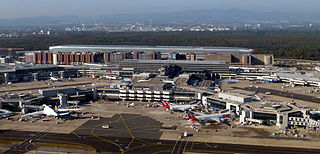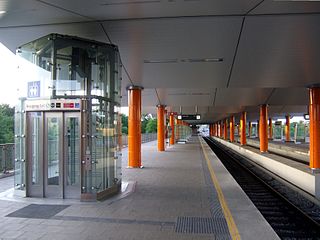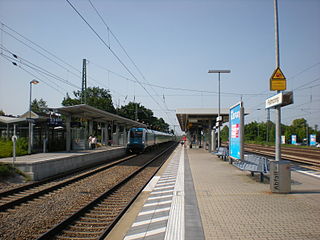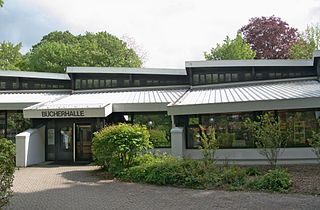
As a densely populated country in a central location in Europe and with a developed economy, Germany has a dense transport infrastructure.

The Berlin U-Bahn is a rapid transit system in Berlin, the capital and largest city of Germany, and a major part of the city's public transport system. Together with the S-Bahn, a network of suburban train lines, and a tram network that operates mostly in the eastern parts of the city, it serves as the main means of transport in the capital.

The Hamburg S-Bahn is a is a rapid transit railway system in the Hamburg Metropolitan Region. Together, the S-Bahn, the Hamburg U-Bahn, the AKN railway and the regional railway form the backbone of railway public transport in the city and the surrounding area. The network has operated since 1907 as a commuter rail system, under the direction of the state railway, and is a member of the Hamburger Verkehrsverbund. There are six lines, serving 68 stations, on 147 kilometres (91 mi) of route. On an average working day the S-Bahn transports about 590,000 passengers; in 2010 about 221 million people used the S-Bahn.

The Hamburg U-Bahn is a rapid transit system serving the cities of Hamburg, Norderstedt, and Ahrensburg in Germany. Although referred to by the term U-Bahn, most of the system's track length is above ground. The network is interconnected with the city's S-Bahn system, which also has underground sections. It is operated by Hamburger Hochbahn within the Hamburger Verkehrsverbund (HVV). It was opened in February 1912, and comprises four lines serving 93 stations, with a route length of 106.4 kilometres (66.1 mi) in 2019.

The Nuremberg U-Bahn is a rapid transit system run by Verkehrs-Aktiengesellschaft Nürnberg, which itself is a member of the Verkehrsverbund Großraum Nürnberg. The Nuremberg U-Bahn is Germany's newest metro system, having begun operation in 1972, although the Nuremberg-Fürth route (U1) uses part of the right of way of the Bavarian Ludwig Railway, Germany's first passenger railway opened in 1835. The current network of the U-Bahn is composed of three lines, serving 49 stations, and comprising 38.2 kilometres (23.7 mi) of operational route, making it the shortest of the four metro systems in Germany, behind Berlin, Hamburg and Munich.

München Hauptbahnhof or Munich Central Station is the main railway station in the city of Munich, Germany. It is one of the three stations with long-distance services in Munich, the others being Munich East station and Munich-Pasing station (München-Pasing). München Hauptbahnhof sees about 450,000 passengers a day, which puts it on par with other large stations in Germany, such as Hamburg Hauptbahnhof and Frankfurt (Main) Hauptbahnhof. It is classified by Deutsche Bahn as a category 1 station, one of 21 in Germany and two in Munich, the other being München Ost. The mainline station is a terminal station with 32 platforms. The subterranean S-Bahn with 2 platforms and U-Bahn stations with 6 platforms are through stations.

The Nuremberg S-Bahn is an S-Bahn network covering the region of Nuremberg, Fürth and Erlangen which started operations in 1987 and is now integrated into the Greater Nuremberg Transport Association. The full length of the five current lines is about 277.6 kilometres.

Munich Marienplatz is an important stop on the Munich S-Bahn and U-Bahn network, located under the square of the same name in Munich's city centre. The S-Bahn lines , , , , , and intersect with the U-Bahn lines and . The station is one of the most frequently used stations in the network, with up to 24,400 people transferring and 8,000 passengers entering or exiting each hour. In 2007, 175,400 people used the station daily on weekdays, including entries, exits and transfers.

Munich East station is a railway station in Munich, the state capital of Bavaria, Germany. It opened as Haidhausen station in 1871 on the new Munich–Mühldorf and Munich–Rosenheim railway lines. The station is operated by DB Station&Service, a subsidiary of Deutsche Bahn AG. It is classified as a Category 1 station, one of 21 in Germany and two in Munich, the other being München Hauptbahnhof. It is the city's third interregional station besides München Hauptbahnhof in the city centre and München-Pasing in the west.

Munich-Neuperlach Süd (south) is a railway station in Munich, the state capital of Bavaria, Germany. It is located in the Neuperlach area of the borough of Ramersdorf-Perlach. It serves as an transportation hub for the borough, providing interchange between S-Bahn, U-Bahn, and local bus services.

Munich Karlsplatz is an underground S-Bahn and U-Bahn station below the Karlsplatz in central Munich. It is one of the busiest stations in Munich, as it is located at the western end of Munich's Altstadt.

Munich-Feldmoching station is a station in the Feldmoching section of Munich District 24, Feldmoching-Hasenbergl. Two rail lines serve the station, S-Bahn line and U-Bahn line .

Munich-Trudering station is an interchange station of the Munich S-Bahn and the Munich U-Bahn in the borough of Trudering-Riem in the Bavarian capital of Munich.

Munich-Moosach station is a railway station in the Moosach district of Munich, the capital of the German state of Bavaria. It consists of an above-ground station for regional and Munich S-Bahn services and an underground station for the Munich U-Bahn.

The Nuremberg tramway network is a network of tramways forming part of the public transport system in Nuremberg, a city in the federal state of Bavaria, Germany. The system reached the neighboring city of Fürth from its opening year to almost a century later when construction of the U1 subway line led to the withdrawal of tram service to and within Fürth. During that era and referring to it historically in literature or nostalgic activities, the system was known as “Nürnberg-Fürther Straßenbahn“. For example, a local association dedicated to preserving the history and heritage of the tram network as well as old rolling stock calls itself “Freunde der Nürnberg-Fürther Straßenbahn“ The system is planned to cross the municipal boundaries of Nuremberg once more, if and when the extension to Erlangen and from there to Herzogenaurach dubbed "Stadtumlandbahn" opens.

#

FRTC Frankfurt is a firefighting training facility at Eckenheim in Frankfurt am Main, Germany. It is notable for having its own standard gauge rail system and mock-Frankfurt U-Bahn underground station.
Armin Grau is a German physician and politician of the Green Party who has been serving as a member of the Bundestag since the 2021 elections.


















